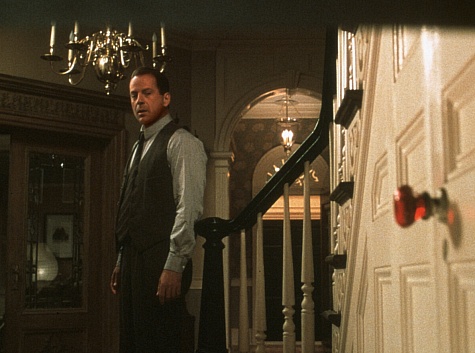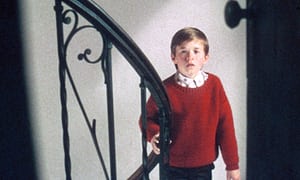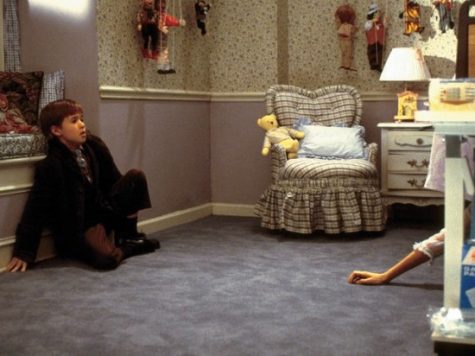They’re Everywhere: Horrorfest–The Sixth Sense

Photo Credits: cinemaschallenge.blogspot.com
The Sixth Sense obtains its iconicism through its use of psychological frights, empathy-provoking characters, and a massive twist ending that leaves the audience shocked.
December 18, 2019
Everyone is afraid of something. Whether you’re afraid of the dark, of spiders, or of failing your finals, there is one fear that is shared by nearly every person on the planet–the fear of the unknown. Often, true fear is lost in horror movies that exhibit tangible fears, such as zombies, werewolves, or even psychotic cannibals. These things are “real”, visible frights that, though scary, exist within the earthly realm. But what really makes the hair stand up on that back of our necks are the untouchable things–the invisible hand on your cheek, the wink of an eye in a dark room, and feeling as if you are never truly alone.
This flair for invoking the fear of the unseen supernatural is what inspired M. Night Shyamalan to create the film The Sixth Sense, and is also what established him as one of the most influential writers and directors of modern cinema.
Released in August of 1999, The Sixth Sense was nominated for six Academy Awards and was the highest-grossing horror film in the world for 18 years, when in 2017 it was surpassed by IT.
The film stars Haley Joel Osment and Bruce Willis, who play the role of a psychiatrist (Malcolm) and his 9 year old patient (Cole) ,who can communicate with the dead as if they were living people. The movie follows Malcolm as he encourages Cole to use his gift purposefully and help the dead move into their next life, and Cole in turn helps Malcolm reconcile with his wife, Anna.
This August, Shyamalan was interviewed by Hollywood Reporter for the film’s twentieth anniversary. When speaking about how Osment brought his role to life, Shyamalan expressed his initial doubts about Osment.
“[He was] this really sweet cherub, kind of beautiful, blond boy,” Shyamalan said. “I saw this part as this brooding, darker, enigmatic child. But he nailed it with the vulnerability and the need — I guess that’s the best way to describe it. He was able to convey a need as a human being in a way that was amazing to see. He did that through the entire process.”
According to my ranking scale, The Sixth Sense scores* a 54/80 overall.
Color Scheme

Willis views a bright ruby doorknob, proving the importance of red detailing in The Sixth Sense.
The Sixth Sense included a fascinating element that is actually important to many classic horror films–the deliberate omission of the color red throughout the majority of the film so that it could be used in deliberate moments to add dramatic effect. I ranked Color Scheme a 7 as a result, because the small, indicative pops of red throughout developed the movie’s element of drama.
Costuming

Cole (Haley Joel Osment) is frequently seen around the color red, as is seen in the color of his sweater during the infamous birthday party scene.
Costuming earned a 6. Without revealing too much of the twist ending, every article of clothing worn by Malcolm throughout the movie hold significance later on if you’re a movie viewer who pays close attention to details. Additionally, some of the ghosts wear period-appropriate costumes, such as the outfit worn by the ghost that died in the 1970s.
Special Effects

The special effects in The Sixth Sense were incorporated in a shocking and gruesome way that made the movie far scarier.
The use of special effects was perhaps the strongest aspect of The Sixth Sense. This category easily earns a 10. Though the effects used in the movie appear a bit dated now, they were revolutionary in the 90s, and any film aficionado can recognize this. The subtle–yet dark–incorporation of blood was tasteful yet frightening, and every effect added intrigue and terror to the film. I don’t award categories a 10 very easily, but the special effects in The Sixth Sense very much deserve one.
Gore

Cole views the ghost of a biker who was hit by a car.
Gore was a lower category for The Sixth Sense, primarily because the movie didn’t really need to rely on graphic scenes of violence to scare its viewers. Scoring a 5, the scenes of gore included were brief but rather intense, which were a perfect addition to the film. Fleeting flashes of blood and violence were more than sufficient in shocking the audience, so though Gore ranked low in terms of inclusion, it was artfully incorporated.
Date and Time Period

Cole and Malcolm discover the location of a Revolutionary-War era gallows, where they see the ghost of a hanging woman.
Date and Time Period were virtually irrelevant in The Sixth Sense, so a 5 is the score earned by the movie. Some of the ghosts were from alternate time periods, which was an interesting inclusion, but similarly to The Silence of the Lambs, The Sixth Sense could have been set in any other context from the past few decades and still held the same cinematic influence.
Soundtrack

The soundtrack for The Sixth Sense was basically just a compilation of basic, run-of-the-mill “suspense building” songs. The soundtrack was actually rather limited, including a meager 7 songs total, so Soundtrack is really only deserving of a 4 for this movie. The soundtrack included music from The Supremes and from composer Franz Shubert.
The Monster

Every ghost in the movie was a person who had died, didn’t know they were dead, and were seeking passage into the next realm–which is where Cole comes in.
“The Monster” was actually a confusing element in The Sixth Sense. It could be argued that “the monster” is a collective entity, made up of a combination of malevolent spirits, people who harmed the spirits in their corporeal lives, and the very concept of ghosts itself. However, I think that it is unfair to claim that ghosts (as a group) in the movie should be counted as the villain overall, simply because some of the ghosts were neutral–or even benevolent–figures in the film that do not deserve the label of “the monster”. As I previously mentioned, the most frightening thing of all for people is the simple concept of the afterlife, because no one truly knows what it ensues (or if it exists at all). This renders the ghosts as terrifying creatures, benevolent or not, because the movie makes the afterlife a fixed reality. Therefore, “The Monster” is deserving of a strong 8.
Suspense Factor

The Sixth Sense is filled with dark twists and turns that develop suspense consistently throughout.
Suspense Factor was another high scoring category for The Sixth Sense. The movie sets up aspects of the plot like careful, intentional landmines–they are unexpected but utterly explosive when discovered. Every frightening element of the film adds together to end the movie with a gasp-out-loud shocking ending that is somehow both tragic and satisfying at the same time. The Sixth Sense could be classified as a mystery film as well as a horror film, because the viewer ends up feeling like they were piecing a massive, intense puzzle by the conclusion of the film. Suspense Factor most definitely earned a 9.
The Sixth Sense was my first horror film, and it is also what made me fall in love with the genres of horror and mystery. Another psychological thriller, it allows the audience to feel as if the stone-cold hands of Death himself are tapping you on the shoulder, hitching the breath in your chest and making your toes curl. The Sixth Sense is a perfect reminder that things aren’t always as they seem.
You know that thing that goes bump in the night? It may be far more than your imagination.
Cole Sear: I’m ready to tell you my secret now.
Dr. Malcolm Crowe: Okay.
Cole Sear: Come closer.
Cole Sear: I see dead people. They don’t know they’re dead.
Dr. Malcolm Crowe: Where are they?
Cole Sear: Everywhere.
*In case you need a refresher, each movie is rated in 8 categories–Color Scheme, Costuming, Special Effects, Gore, Date & Time Period, Soundtrack, “The Monster” and Suspense Factor. These scores, which are out of 10, are added together to create an overall ranking, the highest being 80.


